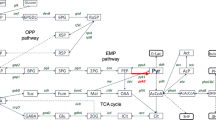Abstract
The effect of equisetin, an antibiotic produced byFusarium equiseti, has been studied on mitochondrial functions (respiration, ATPase, ion transport). Equisetin inhibits the DNP-stimulated ATPase activity of rat liver mitochondria and mitoplasts in a concentration-dependent manner; 50% inhibition is caused by about 8 nmol equisetin/mg protein. The antibiotic is without effect either on the ATPase activity of submitochondrial particles or on the purified F1-ATPase. It inhibits both the ADP- or DNP-activated oxygen uptake by mitochondria in the presence of glutamate + malate or succinate as substrates, but only the ADP-stimulated respiration is inhibited if the electron donors are TMPD + ascorbate. It does not affect the NADH or succinate oxidation of submitochondrial particles. Equisetin inhibits in a concentration-dependent manner the active Ca2+-uptake of mitochondria energized both by ATP or succinate without affecting the Ca2+-uniporter itself. The antibiotic inhibits the ATP-uptake by mitochondria (50% inhibition at about 8 nmol equisetin/mg protein) and the Pi and dicarboxylate carrier. It does not lower the membrane potential at least up to 200 nmol/mg protein concentration. The data presented in this paper indicate that equisetin specifically inhibits the substrate anion carriers of the mitochondrial inner membrane.
Similar content being viewed by others
Abbreviations
- EGTA:
-
ethyleneglycol bis/-aminoethylether/-N, N-tetraacetic acid
- DNP:
-
2, 4-dinitrophenol
- TMPD:
-
N,N,N′,N′,tetramethyl-p-phenylenediamine
- CCP:
-
carbonylcyanide-m-chlorophenyl hydrazone
- TPP:
-
tetraphenyl-phosphonium
- Hepes:
-
/4,(2-hydroxyethyl)-1-piperazine-ethanesulfonic acid/
References
Aquila, H., Link, T. A., and Klingenberg, M. (1987).FEBS Lett. 212 1–9.
Beyer, K., and Klingenber, M. (1985).Biochemistry 24 3821–3826.
Burmeister, H. R., Bennett, G. A., Vesonder, R. F., and Hesseltine, C. W. (1974).Antimicrob. Agents Chemother. 5 634–639.
Gregg, C. T. (1963).Biochim. Biophys. Acta 74 573–587.
Kamo, N., Muratsugu, M., Hougoh, R., and Kobatake, Y. (1974).J. Membr. Biol. 49 105–121.
König, T., and Kapus, A. (1990). Abstr. 20th FEBS Meeting, p. 59. No. 206
König, T., Kocsis, B., Meszáros, L., Nahm, K., Zoltán, S., and Horváth, I. (1977).Biochim. Biophys. Acta 462 380–389.
König, T., Stipani, I., Horváth, I., and Palmieri, F. (1982).J. Bioenerg. Biomembr. 14 297–305.
König, T., Ormos, P., and Horváth, I. (1986).EBEC Short Reports, Vol. 4, p. 258.
Krämer, R., and Palmieri, F. (1989).Biochim. Biophys. Acta 374, 1–23.
Ligeti, E., and Fonyó, A. (1984).Eur. J. Biochem. 139 279–285.
Ligeti, E., Brandolin, G., Dupont, Y., and Vignais, P. V. (1985).Biochemistry 24 4423–4428.
Müller, M., Cheneval, D., and Carafoli, E. (1984).Eur. J. Biochem. 140 447–452.
Nicholls, D. G., and Akerman, K. E. O. (1982).Biochim. Biophys. Acta 683 57–88.
Nyrén, P., and Strid, A. (1989).Arch. Biochem. Biophys. 268 659–668.
Palmieri, F., Bisaccia, F., Capobianco, L., Iacobazzi, V., Indiveri, C., and Zara, V. (1990).Biochim. Biophys. Acta 1018 147–150.
Paradies, G., and Ruggiero, F. M. (1988).Biochem. Biophys. Res. Commun. 156 1302–1307.
Paradies, G., and Ruggiero, F. M. (1991).Arch. Biochem. Biophys. 284 332–337.
Paradies, G., Ruggiero, F. M., and Dinoi, P. (1991).Arch. Biophys. Acta 1070 180–186.
Schacterie, G. R., and Pollak, R. C. (1973).Anal. Biochem. 51 654–655.
Schnaitman, C., and Greenawalt, J. W. (1968).J. Cell Biol. 38 158–175.
Schnaitman, C. E., Erwin, V. G., and Greenawalt, J. W. (1967).J. Cell Biol. 32 719–735.
Vesonder, R. F., Tjarks, L. W., Rohwedder, W. K., Burmeister, H. R. and Laugal, J. A. (1979).J. Antibiotics 32 759–761.
Wohlrab, H. (1986).Biochim. Biophys. Acta 853 115–134.
Wojtczak, L., and Zaluska, H. (1967).Biochem. Biophys. Res. Commun. 28 76–81.
Author information
Authors and Affiliations
Rights and permissions
About this article
Cite this article
König, T., Kapus, A. & Sarkadi, B. Effects of equisetin on rat liver mitochondria: Evidence for inhibition of substrate anion carriers of the inner membrane. J Bioenerg Biomembr 25, 537–545 (1993). https://doi.org/10.1007/BF01108410
Received:
Issue Date:
DOI: https://doi.org/10.1007/BF01108410




